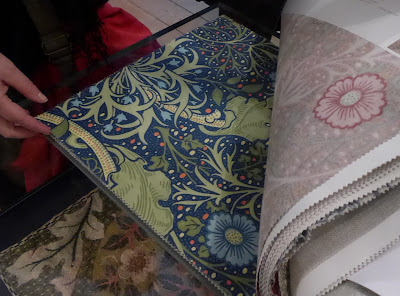We went to the William Morris Gallery with the general election looming.
Should have clocked beforehand, this wasn't just about arts and crafts, but politics too.
William Morris was born in Walthamstow in the 19th century.
Not the Walthamstow we know today at the end of the Victoria Line,
...but a village in the Essex countryside, on the edge of Epping Forest.
We read that Morris was a social activist, becoming a socialist aged 50. But how did his anti-capitalist ideas fit into a life of arts and crafts?
William Morris, the eldest son, born into a wealthy family.
The kind of family who had their portraits painted.
Not necessarily the son they had in mind.
Marrying beneath him,
and rejecting the idea of becoming a clergyman to become an interior designer.
A designer of...
A designer of...
...wallpaper,
...ceramic tiles,
...furniture,

...tapestries
...and textiles.
Morris believed that beauty is a basic human need and created art for everyone.
Morris and Co built a brand that "only the most avant-garde bought from".
Bought by people with "rebellious taste".
That threw up a few questions. Today these quite mainstream designs don't strike us as rebellious and they're not necessarily that affordable. But Morris wasn't a fine artist, he applied his sense of design and values to household furnishings, bringing art into everyday life.
Morris hated the effects of industrialisation; slums, overcrowding, diseases and pollution.
His workshops were places where workers enjoyed clean air and rural surroundings.
Fabrics and wallpaper were block-printed, rather than use industrial rollers.
This was a time consuming process, making Morris & Co's products quite costly to buy.
William Morris set up shop in 1877 in Oxford Street and lived upstairs.
His major competitor was Libertys. That says something about his target market.
Choosing fabric today, little has changed.
The brand has endured and the William Morris Gallery has since embraced some higher tech 21st century printing techniques. On doors. I love good museum loos.
Until our visit to the William Morris Gallery we hadn't associated these well-known designs with his political ideals, of art for all and a fight against the poor conditions of industrial manufacturing. This still rings true when you consider much of worldwide manufacturing today. Discussing the impending general election, we had heard plenty of politician talk about wages, taxes and the like, but what about the arts and cultural learning? It feels like the arts are being side-lined.
What would William Morris make of today's political parties? Art, manufacturing, marketing and workers conditions all came together under his socialist remit. I'm not saying he got it all right, but I'd like to see the arts given equal weight and consideration in the political debate, especially when it comes to education.
The William Morris Gallery is open Wednesdays to Sundays.
A short walk from Walthamstow Central station. Details on their website, here.
If you would like to see excellent advocacy on the value of arts learning, check out the Cultural Learning Alliance's website. Read their manifesto, here, for "The benefits for young people of participating in arts and culture". The CLA continues to ensure that cultural learning is part of political debate. Rightly so.

















































